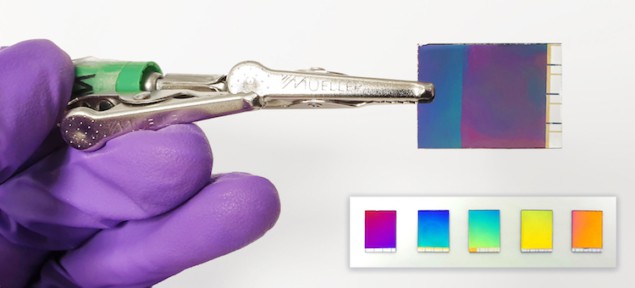
Thinking of taking your e-reader on holiday this summer? Sitting around in the sunshine catching up on all the books you haven’t had time to read may soon be even more enjoyable thanks to a new reflective screen technology that works without a backlight. Developed by Andreas Dahlin and colleagues at Sweden’s Chalmers University, the technology is based on colour-changing nanostructures, and it could be a promising alternative to the energy-intensive digital screens currently employed in smartphones and tablets.
Conventional digital screens require a backlight to illuminate the text or images they display. Not only does this require extra energy, it also means that screens are sometimes too dim to be comfortably used outdoors – especially on bright, sunny days.
To overcome this problem, researchers have been exploring ways of incorporating so-called structural colours into the “electronic paper” of reflective displays. Materials that exhibit structural colour do not contain dyes and pigments. Instead, they rely on nanostructures that reflect or scatter light waves of certain frequencies, and they do not fade over time – especially if the structures are made of less-reactive “noble” metals such as gold or platinum.
Not bright enough
One particularly promising technique for making structural colours is to combine metallic nanostructures with materials that are electrochromic – that is, they change colour when a small electrical voltage is applied to them. Until now, however, devices based on the strongly electrochromic material tungsten trioxide (WO3) often lacked colour purity (chromaticity) and were not bright enough for practical applications.
The Chalmers team explains that this lack of brightness (low reflectance) poses a serious challenge for designers of electronic paper because only a fraction of the display’s surface will show a given colour when using subpixels arranged side by side. To reduce the number of subpixels required, they needed to create electrochromic surfaces that can provide many different colours.
Inverted design
In their latest study, Dahlin and colleagues developed a new type of inorganic electrochromic nanostructure that has both a high reflectance and an excellent colour range. They did this by modifying the design of an ultrathin flexible material based on layers of WO3, gold and platinum that they previously developed in their laboratory. While this older design could reproduce all the colours an LED screen can display and required only a tenth of the energy of a standard tablet, the colours on this earlier reflective screen were not displayed with optimal quality.
The researchers have now reversed the thin-film layers within this structure in a way that allows all the electrical components to be “hidden” behind the reflective surface. This involved placing the electrically conductive material in the device underneath the pixelated nanostructure that reproduces the colours, rather than above it as was originally the case. “The new design means you look directly at the pixelated surface, therefore seeing the colours more clearly,” Dahlin explains. “They can be seen through a glass cover, which will make colour images much easier to see in a real device.”
Commercialization prospects
The researchers showed that their nanostructures clearly outperform the best colour e-reader on the market today in terms of both colour range/quality and brightness, and Dahlin is confident that a product containing the new technology could be developed commercially within a “couple of months if a large player on the market really decides to give it a try”.

Bright colour-changing skins
“As well as smart phones and tablet screens, the main application would be colour-changing surfaces or displays for use in situations where light is high, such as outdoors during the day,” he tells Physics World. “The devices are not fast enough to show video, so if used in advertising, they would offer energy and resource savings compared with both printed posters or moving digital screens.”
The researchers, who report their work in Nano Letters, say they are now trying to make the same nanostructures using another process that wastes less gold and platinum in the preparation stage.
